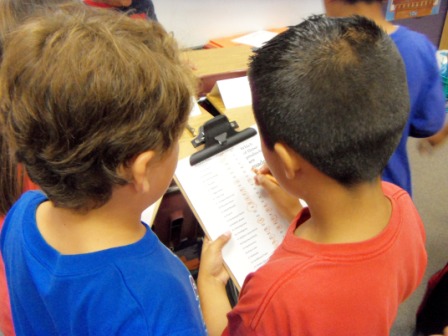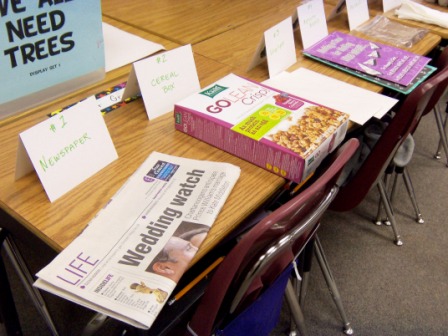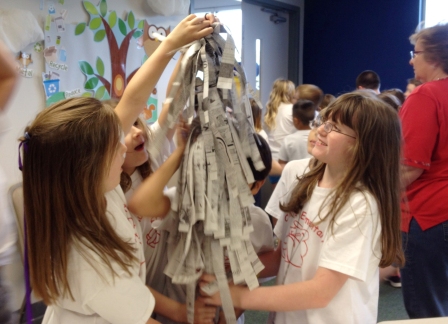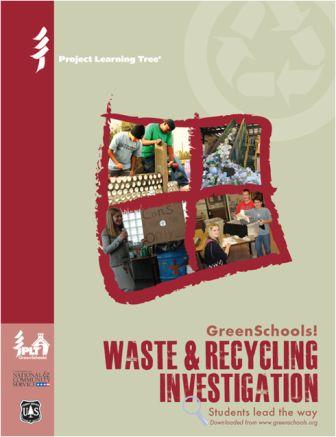We All Need Trees, Even Recycling Centers
By Liz Swafford in Educator Tips & Stories
 Third grade students with “upcycled” clipboards, a rectangular piece of cardboard with a black binder clip, carefully read a list of items from their worksheet. Their challenge is to identify which of the 25 items displayed are made from trees. If they think that all or even just part of the item is made from trees they need to circle “Yes”. If these young investigators come to the conclusion that there’s no way the item comes from trees, they circle “No.”
Third grade students with “upcycled” clipboards, a rectangular piece of cardboard with a black binder clip, carefully read a list of items from their worksheet. Their challenge is to identify which of the 25 items displayed are made from trees. If they think that all or even just part of the item is made from trees they need to circle “Yes”. If these young investigators come to the conclusion that there’s no way the item comes from trees, they circle “No.”
Number one on the list is newspaper. Other items on display are activity books, a pinecone, pecans, a wooden ruler, a small branch, chocolate sprinkles, gum, a small pack of fig Newton’s, a pair of tongue depressors, rubber gloves, toothpicks, and a cereal box.
 As students ponder the items while making their way around the room, visiting teachers and parents start to wonder, too. “Could Parmesan cheese really have some tree in it?” “What’s charcoal made of anyway?” “Why are there rubber bands here? Surely that’s a no!” “What’s this got to do with recycling?”
As students ponder the items while making their way around the room, visiting teachers and parents start to wonder, too. “Could Parmesan cheese really have some tree in it?” “What’s charcoal made of anyway?” “Why are there rubber bands here? Surely that’s a no!” “What’s this got to do with recycling?”
Visitors of the Recycling Center participate in this activity, “We All Need Trees” (Activity 13) from PLT’s PreK-8 Environmental Education Activity Guide during their tours as part of the Dalton-Whitfield Solid Waste Authority’s education program. Schools in Whitfield County can schedule a free tour of the landfill and recycling center facilities to learn where their garbage goes and what happens to things they recycle at school.
Once the participants complete their worksheet they gather in the middle of the room to review the answers. If they have extra time while waiting for others to finish they read the student page called “Tree Readings” (also available in Spanish) from the same activity. Some students are really surprised to know that a newspaper could be made from trees. But the best reactions come when students realize that chewing gum, Parmesan cheese, chocolate sprinkles, and even rubber gloves, are produced, at least in some part, by trees and forests.
“You mean I eat trees???” one young boy exclaimed as he heard that Parmesan cheese contains cellulose from trees to keep it from sticking together. He is certain to remember that fact every time he sprinkles Parmesan on his pizza.
After discovering ALL of the items are actually forest products, students are prepared to learn more about the benefits of trees. The group discusses how they have enjoyed the shade of trees, climbing them, and the animals they’ve seen that live in and around trees. They also learn the basics of how paper is made, how recycling paper allows us to use the paper fiber as many times as possible and helps to conserve trees.
 The session ends with a great visual reminder that paper comes from trees with the use of the newspaper tree. Newspapers are made from trees, so we ask if we can make a tree from newspaper. Students look amazed to see a tube of rolled up newspapers stretched into a really tall tree that kind of looks like a palm tree covered with newsprint. Instructions to make this easy, yet memorable magic trick or science experiment, are available online.
The session ends with a great visual reminder that paper comes from trees with the use of the newspaper tree. Newspapers are made from trees, so we ask if we can make a tree from newspaper. Students look amazed to see a tube of rolled up newspapers stretched into a really tall tree that kind of looks like a palm tree covered with newsprint. Instructions to make this easy, yet memorable magic trick or science experiment, are available online.
PLT’s We All Need Trees activities are important because they help teach that recycling is part of the larger picture of environmental conservation. The items displayed are, for the most part, commonly found in homes, schools, and outdoors. It’s also an activity that is flexible, and transferable from on-site tours to classroom visits and even booths at local events. You can use it with first graders, and even college students (An age appropriate adaptation of We All Need Trees is available for students ages 3-6 in PLT’s Environmental Experiences for Early Childhood materials). No matter what age you are there’s always a new tree product to discover. Can you think of one you’ve used today?
Recycle with PLT
 Environmental Experiences for Early Childhood
Environmental Experiences for Early Childhood
- PreK-8 Environmental Education Activity Guide
- Activity 13 We All Need Trees
- Activity 37 Reduce, Reuse, Recycle
- Activity 51 Make Your Own Paper
- Activity 52 A Look at Aluminum
- PLT GreenSchools! Waste and Recycling Investigation
- Schools across the country are implementing recycling programs
- Want to improve or start a recycling program at your school?
(up to $3,000 for registered PLT GreenSchools!)
- PLT’s Municipal Solid Waste Module
- Additional curriculum resources are available for each PLT activity
Recycle with Keep America Beautiful’s Recycle-Bowl
Are you looking for a fun and creative way to increase school recycling participation? Keep America Beautiful‘s annual “Recycle-Bowl” is a comprehensive nationwide recycling competition for elementary, middle and high-school students. Public, private and charter schools are eligible.
Upcycle: The reuse of discarded materials in such a way as to create a product of a higher quality or value than the original. The example in this article references the new clipboards that were made from recycled or discarded materials.
Photo 1: Students work in teams of two on their tree products worksheet for the PLT Activity “We All Need Trees.” Photo by Liz Swafford.
Photo 2: A newspaper is the first item on display for students trying to decide what items are made from trees during a class visit. Photo by Liz Swafford.
Photo 3: Students from Cohutta Elementary School take one last chance to make the newspaper tree grow during the end of a field trip to the recycling center in Dalton, Georgia. Photo by Liz Swafford.
Liz Swafford is the Recycling & Education Program Coordinator for the Dalton-Whitfield Solid Waste Authority in Dalton, GA. Contact her by email at lswafford@dwswa.org, call 706-278-5001, or visit www.DWSWA.org to learn more about the Environmental Education program.


